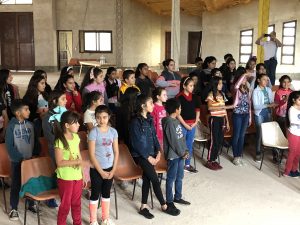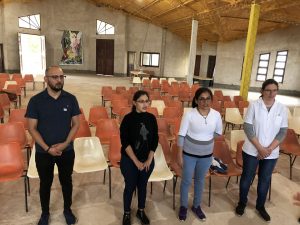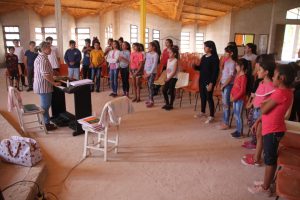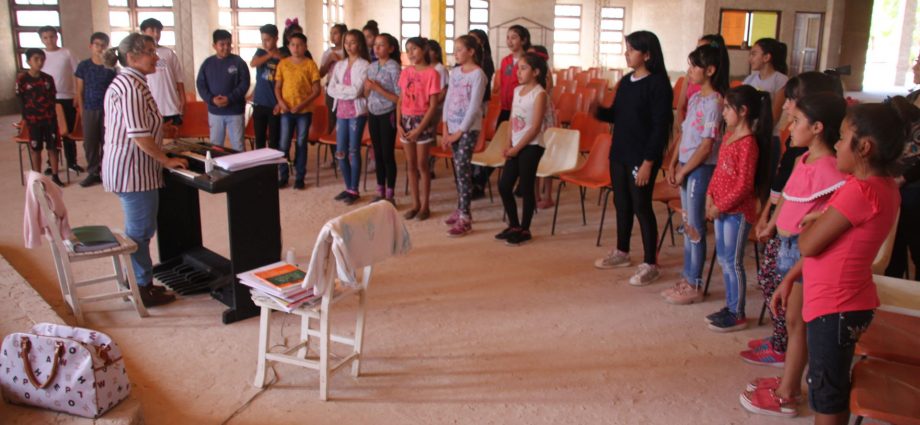Conductors Without Borders – OFADAC/IFCM
Miraflores (El Impenetrable), Chaco Province, Argentina
As part of the agreement signed this year and originally proposed by the Argentine Federated Organisation of Choral Activities (OFADAC), as part of its 3rd Argentinean and 1st Latin American Choral Congress held in Tandil (Province of Buenos Aires) in May 2018, OFADAC launched the Conductors Without Borders (CWB) programme.
A public and open call for expressions of interest from choral conductors in Argentina was launched through the organisation’s website (www.ofadac.org) in order to select two regular conductors and three alternatives to carry out Conductors Without Borders in the two proposed locations: Miraflores, in the region of the El Impenetrable National Park in the Province of Chaco and the Huilque Menuco area located in the Andean region of the Patagonic Province of Neuquén.
This was met with a very good reception from the Argentine professionals, and led to around twenty applications. The selection panel, composed of Oscar Escalada (member of both institutions) and Annele Moroder (Member of the OFADAC and former Director of the Isaías Orbe Conservatory of the City of Tandil), appointed Marisa Lilian Anselmo and Roxana Lucía Muñoz as the resident conductors and Laura María Favre, Romina Paula Fernández and María Jesús Bonel as alternatives. After being told of their success, the newly appointed conductors immediately accepted their positions with Marisa Anselmo formally in charge of the project in Miraflores and Roxana Muñoz of that in Huilque Menuco. At the same time, with thanks to Mario Figueroa, Vice President of OFADAC, the funds necessary to carry out the programme were obtained, by including CWB in the agreement that OFADAC and ADiCoRA (Association of Directors of Choirs of the Argentine Republic) have with the INAMU (National Institute of Music). To this end, Rubén Videla was appointed to manage the first stage of the programme in Miraflores and Mario Figueroa himself to manage the second stage in Huilque Menuco.
CWB Miraflores
The beginning
In order for the first edition of CWB in Argentina to take place, contact was made in June with Prof. Adriana Cragnolini, Director of the School No. 1034, who was very interested in the programme being carried out in her town. As soon as Prof. Cragnolini accepted the role of local coordinator of CWB, the next steps were to:
- establish contact with the municipal council to request their support through the use of a physical space or public infrastructure
- conduct a survey in the community to find possible local mentors with knowledge of music (instruments, music reading, ) or qualified in the field of music;
- open registration to children from eight to 12/14 years in order to become members of the choir;
- promotethe programme through local media and social networks, for which a flyer was designed and shared with an explanatory text;
The dates were set for the programme to take place from 18 to 26 October .
In Miraflores
After having arrived in Miraflores, the first activity for Marisa Anselmo (appointed conductor of Conductors Without Borders), Thierry Thiébaut (Vice President of the IFCM) and Rubén Videla (Secretary of OFADAC) was a meeting with all the local mentors who received a briefing on how the programme would run.
They were informed that the programme would be carried out in the San Rafael Arcángel Church (temple under construction). Children who attend school in the afternoon, would attend from 9:00 a.m. to 11: 00 a.m. and students who attend school in the morning, would attend from 3:00 p.m. to 5:00 p.m. And then there would be specific activities for mentors, from 5:00 p.m. to 7:00 p.m. It was suggested that in addition to attending their own activities, it would be very important for the mentors to attend at least one of the two daily rehearsals with the children.
Over nine days in Miraflores a total of 14 rehearsals with the children were held, eight classes for the mentors and a final concert to sample the “Singing Children of Miraflores Chorale”, the repertoire for which included about 12 musical works learnt at that time, some of which were conducted by the local mentors. See below the report by Marisa Anselmo.

Report of the project in Miraflores (Chaco) between October 18 and 26, 2019
CORO DE NIÑOS CANTORES DE MIRAFLORES (Singing Children of Miraflores Chorale)
We were able to carry out a great variety of activities with the children who came to participate in the choir and we took on a considerable amount of repertoire. Most of the children in the choir were of Creole origin and some belonged to the Qom community.
From the first meeting they responded positively and enthusiastically to the different musical propositions. The rehearsals sometimes began with melodic echoes of the names of the children (as an introduction), body percussion (which later served as a basis to accompany some of the songs), movements with music (to experience pulse and accent) and ice breaker games for the group. On other occasions they began in the traditional way: with postural exercises, breathing and diction, and then moved on to teaching different songs. Intonation of the C Major scale and practising intervals between a 2nd and an 8ve was always interspersed between the songs that were being learned gradually over the nine days.
As for learning rhythm, body percussion was performed to the pulse and accent of some of the songs (and sometimes we also marched, although the dirt floor caused a lot of dust to rise) and provided the rhythmic base for some of the folkloric genres. Since none of the children knew what a choir was, in some meetings we watched footage of children’s choirs from different cultures performing works of diverse genres and aesthetics (from the Guaraní children’s choir to the Libera Choir in London).
Of the more than 100 songs I thought about introducing to the children, we were able to sing approximately 30. Some of them were used only as training exercises, others were listened to, others we played, and with most of them we were able to begin developing an awareness of how to sing in tune way with rhythmic precision, creating a sound without unnecessary tensions but at the same time driven by the abdominal muscles.
As early as the second or third rehearsal we tried singing in canon (two, three and even four parts, with the help of the mentors and monitors that joined each of the groups). In the song Estaba el negrito aquel we managed to superimpose the main melody above one of the ostinatos.
In the debut concert of the SCMC, 14 songs were performed; 12 of which by the children and the other two by the mentors. I believe that throughout these nine rehearsals we achieved the following objectives:
- Motivated the children to take an interest and remain interested in choral activity.
- Provided intensive musical training both in general and in vocal technique in particular.
- Facilitated access to the highest vocal register for approximately 80% of the children who attended the rehear
- Built up a repertoire that will serve as a basis for future rehearsals and be performed in the concerts scheduled for November and December.
- Established the Singing Children of Miraflores Choral

Training the local mentors:
The group of local mentors was made up of six people, of which only four were able to attend all nine planned meetings, even though a wide range of possible timings was offered to facilitate their involvement. Of the six mentors, two studied music with teachers who taught in the neighbouring town of Castelli and understood the basics of music reading. The other four at the beginning of the training did not read music at all.
After the second meeting with the mentors and a conversation with Thierry Thiébaut in which he commented that in Africa he devoted a part of the rehearsal each day to teaching sol-fa (since he also usually met with groups that predominantly did not read music, although, unlike the Miraflores group of mentors, did have a lot of experience as singers), I decided to do the same and start teaching the group to read music from the book “Successful Sight Singing” by Nancy Telfer, allocating 15 to 20 minutes to this daily.
From this brief but determined foray into the musical language – an activity that they embraced goo-heartedly – it was easier for the mentors to understand the various topics that we were exploring in the rehearsals and they were able to connect more quickly what they observed in the rehearsals of the children’s choir with the content we studied in the classes, especially on the topics of the extension of the child’s voice, diction, types of cue according to the type of word beginning, etc.
Of all the content planned to be tackled, the following was achieved:
- Posture of the choir conductor.
- Ways of marking simple and compound timing.
- Cue for starting phrases as pickups and on the beat, in whole beats and in incomplete beat
- Note endings at the end of and during the course of a piece of music.
- Understanding the most important parts of a rehearsal.
- Song teaching technique: Echo without interruption; Shared melody (singing with the conductor and from recordings).
- Frequent tuning problems presented by the children without musical traini
- Location of the strings in front of the conductor during the rehearsal and at the concert.
- Use of keyboard, guitar and recordings in the rehearsal.
- Vocal mechanisms: Respiratory system / Sound system / Resonator.
- Breathing, exercises, diction.
- Characteristics of the primary school child’s voice: extension, passaggio, range.
- Exercises to help children cross the passaggio.
- Voice change: understanding an outline of the concepts.
- Selecting and gradually increasing the repertoire according to difficulty and the age of the c
- Music reading: locating notes on the staff, notions of pulse, accent and direction and some different lengths of rests (quarter note, eighth note, whole note).

The mentors practised in groups and individually in general on the same repertoire that was taught to children but also with other songs. This content was complemented with:
Practice:
- Ways of marking simple and compound timing.
- Musical examples of cues with pick-ups and off the beat.
- Different types of note endings.
- Characteristics of the child’s voice (extension and passaggio).
Tests:
- Children crossing the passaggio without difficulty.
- Children who remain in the chest register, but the teacher manages to help them ascend using appropriate resources.
- Children who remain in the chest register and the teacher fails to facilitate the crossing of the passaggio either because they do not have the technique or because they have not identified or have failed to use the appropriate strate
- Various proposals for appropriate diction exercises to perform with children.
There were two key elements that facilitated training the choral mentors: their excellent willingness to learn and having incorporated music reading into their training.
Four of the mentors each conducted a song at the concert and one of them, two.
I am very happy to say that a very good team has been formed that will be in charge of Singing Children of Miraflores Chorale, each with different functions and talents, which complement each other.

We were even able to provide a couple of performances in November and December and some new repertoire for the choir to learn. I think it will be very necessary to be able to dedicate some more meetings next year to training the mentors. Although much hard work was done, it is necessary to build on the training that has already been provided and introduce them to further issues that are essential to sustaining the continuity of a choir.
Finally, I want to highlight the invaluable help of Rubén Videla who not only dealt with the logistics required to make Conductors Without Borders happen in Miraflores, but was also attentive to solving the different challenges that presented themselves, in addition to playing the guitar, the tubes, singing as a soloist, singing with the kids, helping out, solving technical issues, etc., etc. He was a very good travel companion!!
I want to thank the OFADAC with all my heart for having given me the opportunity to be part of a project that is so needed, so well designed, and that has sown the seeds of voices, dreams and smiles! Best regards!
Marisa Anselmo
Santa Fe, 31 October 2019
Follow up actions
At the same time, we began making efforts ensure that this project continues in this location, through the active intervention of the Miraflores municipal council.
With this objective, a first meeting was held with the future President of the Municipal Council Prof. Carolina Libré – elected in the latest elections and who will take office on December 10 – who was very interested in the project and promised to seek an interview with the elected mayor, Dr. Jorge Frank.
In the meeting held with Dr. Frank, he pledged in turn to support the project, expressing that he sees the activity as very conducive to “providing entertainment to the children and providing the opportunity to develop potential talents that may be hidden in the children ”, also pointing out that it is a very important tool for their training and contributes – with the creative use of leisure spaces – to preventing children from becoming involved in practices that are very harmful to their health and to the wider community, as there is a serious problem with addictions in the community.
Conclusion:
In my opinion, the objectives of the programme have been largely fulfilled, since the appointed conductor was able to carry out everything she had planned – both with the children and with the local mentors – and in addition, steps have been taken to ensure the ongoing running of this expressive space through local institutions.
I especially appreciate the very good predisposition, and the bonhomie of Thierry Thiébaut (despite the language difficulties), evident in a good part in all the activities carried out.
Rubén Darío Videla
OFADAC Secretary
Edited by Bethany Farr, UK

